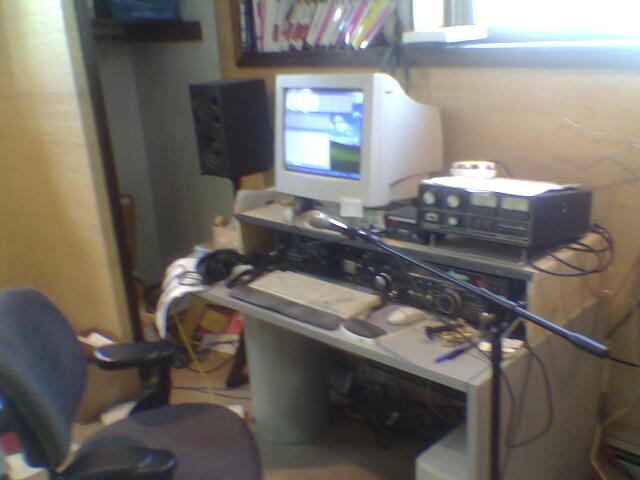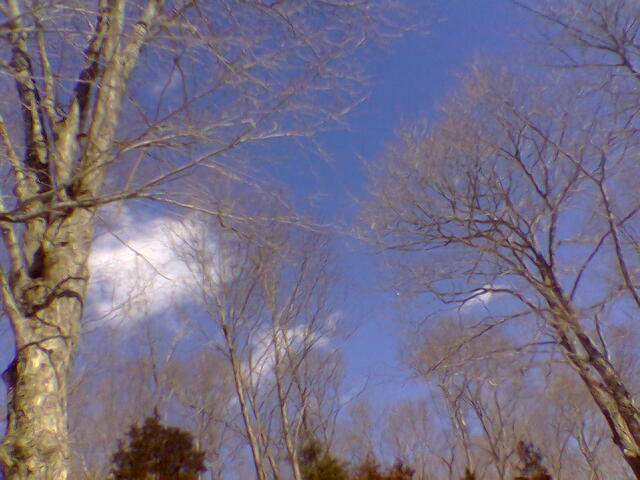At long last, here are a few pictures of the shack and environs.
Nothing fancy. The pictures were taken with the camera on my cell
phone.
Better
pictures taken with a decent camera are available on Flickr.
Skip past the family and the other stuff...
 The shack itself. As usual, it's a mess.
The Icom 765 (on the right) is now the main rig; fantastic
receiver, though I still miss some of the bells and whistles of the
746 (on the left).
I have tried using the 746 as a spotting receiver during contests;
there's some SO2R potential. There's no picture of me wearing two
sets of headphones, one for each rig.
The linear is on loan; I occasionally fiddle with it, but
haven't actually put it to use. The big speakers are not connected
to the radio; the shack doubles as a recording studio from time to time.
The shack itself. As usual, it's a mess.
The Icom 765 (on the right) is now the main rig; fantastic
receiver, though I still miss some of the bells and whistles of the
746 (on the left).
I have tried using the 746 as a spotting receiver during contests;
there's some SO2R potential. There's no picture of me wearing two
sets of headphones, one for each rig.
The linear is on loan; I occasionally fiddle with it, but
haven't actually put it to use. The big speakers are not connected
to the radio; the shack doubles as a recording studio from time to time.
The next couple of pictures are fairly pointless, except as an
exercise in stealth. What's the real secret to wire antennas? There
isn't one. Own big trees. The trees in these pictures approach, or
even exceed, 100 feet. For a while, I had a 40m vertical dipole. It
was too long (about 70'); the bottom end was about 10' off the ground;
and there was plenty of room to spare. An 80m vertical dipole
or 160m quarter-wave wasn't out of the question. The problem with
that tree is that it's in a hole, and looking at a 10-15' rock wall in
the direction of Europe.
 Here's the dipole curtain, which is my main
antenna for the upper HF bands. Can't see it? I can't, either.
Certainly not in the picture. It's invisible from my neighbor's
houses, and from mine. I know where to look, so I can see it when I
want to, but it's certainly not something anyone is going to notice. The
funny thing is that I didn't design it for stealth. There's no special wire,
no special rope. And there's lots of transmission line: coax,
window-line feeding the individual elements.
My neighbors are admirably antenna-tolerant, so I didn't even try to
worry about appearance. But in the end, I got a nearly invisible
antenna, anyway. I'm
convinced that unless you're in an extremely fussy
neighborhood, regular wire and rope will just disappear when it's in
the air.
Here's the dipole curtain, which is my main
antenna for the upper HF bands. Can't see it? I can't, either.
Certainly not in the picture. It's invisible from my neighbor's
houses, and from mine. I know where to look, so I can see it when I
want to, but it's certainly not something anyone is going to notice. The
funny thing is that I didn't design it for stealth. There's no special wire,
no special rope. And there's lots of transmission line: coax,
window-line feeding the individual elements.
My neighbors are admirably antenna-tolerant, so I didn't even try to
worry about appearance. But in the end, I got a nearly invisible
antenna, anyway. I'm
convinced that unless you're in an extremely fussy
neighborhood, regular wire and rope will just disappear when it's in
the air.
 Here's a two-element wire tribander, which I put up for contests. So
far, I've only pointed it South; it's a very effective antenna for
cleaning up South America. I may try pointing it SW for
domestic contests. In reality, the tribander is hardly "stealth"; it
disappears in the picture, but if you look closely, you can see the
spreaders at the ends, and some plastic insulators floating in space.
If you were in my yard, though, you'd notice it (if you looked up);
it isn't particularly
attractive.
Here's a two-element wire tribander, which I put up for contests. So
far, I've only pointed it South; it's a very effective antenna for
cleaning up South America. I may try pointing it SW for
domestic contests. In reality, the tribander is hardly "stealth"; it
disappears in the picture, but if you look closely, you can see the
spreaders at the ends, and some plastic insulators floating in space.
If you were in my yard, though, you'd notice it (if you looked up);
it isn't particularly
attractive.
While this antenna has made it through some storms, it's not built for
heavy duty. It's a temporary antenna. Most of the time, it lives
under the deck, rolled up. Putting the antenna up and taking it down
takes about 20 minutes. I leave the ropes up permanently.
 Here's the twenty meter quad. Unfortunately, it's hung over a valley,
and the picture is taken from a high spot. You can see part of the
driven element on the right side. Despite being lower than it should
be (the top is probably at 50 or 60 feet), it works reasonably well.
Here's the twenty meter quad. Unfortunately, it's hung over a valley,
and the picture is taken from a high spot. You can see part of the
driven element on the right side. Despite being lower than it should
be (the top is probably at 50 or 60 feet), it works reasonably well.
 The shack itself. As usual, it's a mess.
The Icom 765 (on the right) is now the main rig; fantastic
receiver, though I still miss some of the bells and whistles of the
746 (on the left).
I have tried using the 746 as a spotting receiver during contests;
there's some SO2R potential. There's no picture of me wearing two
sets of headphones, one for each rig.
The linear is on loan; I occasionally fiddle with it, but
haven't actually put it to use. The big speakers are not connected
to the radio; the shack doubles as a recording studio from time to time.
The shack itself. As usual, it's a mess.
The Icom 765 (on the right) is now the main rig; fantastic
receiver, though I still miss some of the bells and whistles of the
746 (on the left).
I have tried using the 746 as a spotting receiver during contests;
there's some SO2R potential. There's no picture of me wearing two
sets of headphones, one for each rig.
The linear is on loan; I occasionally fiddle with it, but
haven't actually put it to use. The big speakers are not connected
to the radio; the shack doubles as a recording studio from time to time.
 Here's the dipole curtain, which is my main
antenna for the upper HF bands. Can't see it? I can't, either.
Certainly not in the picture. It's invisible from my neighbor's
houses, and from mine. I know where to look, so I can see it when I
want to, but it's certainly not something anyone is going to notice. The
funny thing is that I didn't design it for stealth. There's no special wire,
no special rope. And there's lots of transmission line: coax,
window-line feeding the individual elements.
My neighbors are admirably antenna-tolerant, so I didn't even try to
worry about appearance. But in the end, I got a nearly invisible
antenna, anyway. I'm
convinced that unless you're in an extremely fussy
neighborhood, regular wire and rope will just disappear when it's in
the air.
Here's the dipole curtain, which is my main
antenna for the upper HF bands. Can't see it? I can't, either.
Certainly not in the picture. It's invisible from my neighbor's
houses, and from mine. I know where to look, so I can see it when I
want to, but it's certainly not something anyone is going to notice. The
funny thing is that I didn't design it for stealth. There's no special wire,
no special rope. And there's lots of transmission line: coax,
window-line feeding the individual elements.
My neighbors are admirably antenna-tolerant, so I didn't even try to
worry about appearance. But in the end, I got a nearly invisible
antenna, anyway. I'm
convinced that unless you're in an extremely fussy
neighborhood, regular wire and rope will just disappear when it's in
the air.
 Here's a two-element wire tribander, which I put up for contests. So
far, I've only pointed it South; it's a very effective antenna for
cleaning up South America. I may try pointing it SW for
domestic contests. In reality, the tribander is hardly "stealth"; it
disappears in the picture, but if you look closely, you can see the
spreaders at the ends, and some plastic insulators floating in space.
If you were in my yard, though, you'd notice it (if you looked up);
it isn't particularly
attractive.
Here's a two-element wire tribander, which I put up for contests. So
far, I've only pointed it South; it's a very effective antenna for
cleaning up South America. I may try pointing it SW for
domestic contests. In reality, the tribander is hardly "stealth"; it
disappears in the picture, but if you look closely, you can see the
spreaders at the ends, and some plastic insulators floating in space.
If you were in my yard, though, you'd notice it (if you looked up);
it isn't particularly
attractive.
 Here's the twenty meter quad. Unfortunately, it's hung over a valley,
and the picture is taken from a high spot. You can see part of the
driven element on the right side. Despite being lower than it should
be (the top is probably at 50 or 60 feet), it works reasonably well.
Here's the twenty meter quad. Unfortunately, it's hung over a valley,
and the picture is taken from a high spot. You can see part of the
driven element on the right side. Despite being lower than it should
be (the top is probably at 50 or 60 feet), it works reasonably well.